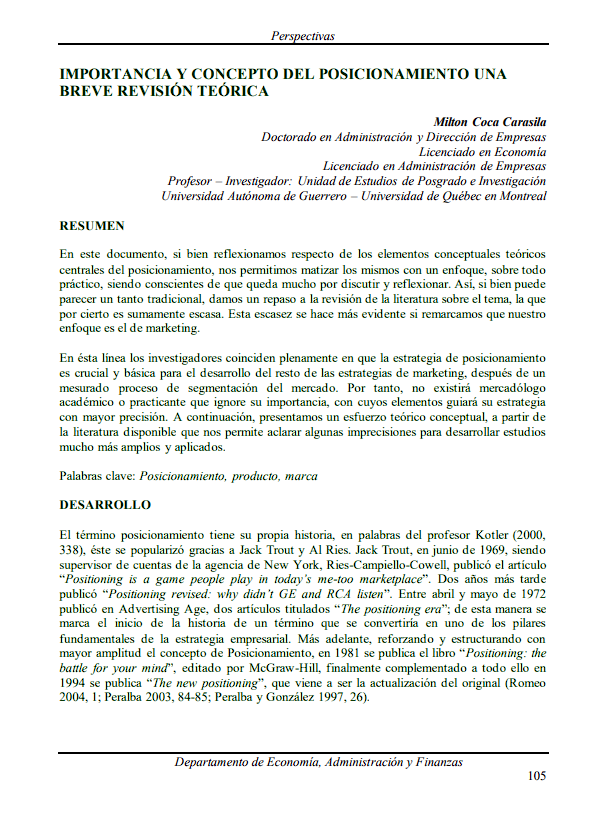Importance and concept of positioning: a brief theoretical review
DOI:
https://doi.org/10.35319/x5q11196Keywords:
Positioning, product, brandAbstract
In this document, although we reflect on the central theoretical conceptual elements of positioning, we allow ourselves to nuance them with a primarily practical approach, being aware that there is much left to discuss and reflect upon. Thus, while it may seem somewhat traditional, we review the literature on the topic, which is notably scarce. This scarcity becomes even more evident when we emphasize that our focus is marketing.
In this regard, researchers fully agree that positioning strategy is crucial and fundamental for the development of the rest of the marketing strategies, following a measured market segmentation process. Therefore, there will be no academic or practicing marketer who ignores its importance, as its elements will guide their strategy with greater precision. Below, we present a theoretical and conceptual effort, based on the available literature, which allows us to clarify some inaccuracies to develop much broader and applied studies.
Downloads
References
Aaker, D. (1994). Gestión del valor de la marca. Madrid: Díaz de Santos.
Aaker, D. & Jacobson, R. (2001). The value of brand attitude in high-technology markets. Journal of Marketing Research, noviembre, pp. 485-493.
Cravens, D. W. & Piercy, N. F. (2003). Strategic Marketing (7ª ed.). Nueva York: McGraw-Hill Irwin.
Czinkota, M. R. & Kotabe, M. (2003). Administración de mercadotecnia (2ª ed.). México: Thomson Learning.
Drucker, P. F. (2002). La gerencia en la sociedad futura. Colombia: Grupo Editorial Norma.
Erdem, T. (1998). An empirical analysis of umbrella branding. Journal of Marketing Research, agosto, pp. 339-351.
Evans, M. (2003). Market segmentation. En M. Baker (Ed.), The Marketing Book (5ª ed.). Gran Bretaña: Butterworth Heinemann.
Gerson, V. (1999). Showing customers your best face. Bank Marketing, enero, pp. 26-30.
Hawkins, D. I., Best, R. J. & Coney, K. A. (2004). Comportamiento del consumidor: construyendo estrategias de marketing (9ª ed.). México: McGraw-Hill/Interamericana.
Herbig, P., Milewicz, J. & Golden, J. (1994). A model of reputation building and destruction. Journal of Business Research, septiembre, pp. 23-31.
Kotler, P. (2000). Dirección de marketing. Edición del Milenio. España: Prentice Hall.
Kotler, P. & Armstrong, G. (2001). Marketing: edición adaptada a Latinoamérica (8ª ed.). México: Prentice Hall.
Kotler, P. & Armstrong, G. (2003). Fundamentos de marketing (6ª ed.). México: Prentice Hall.
Kerin, R. A., Berkowitz, E. N., Hartley, S. W. & Rudelius, W. (2004). Marketing (7ª ed.). México: McGraw-Hill.
Lambin, J. J. (1997). Marketing estratégico (3ª ed.). España: McGraw-Hill.
Lerma, K. A. (2004). Mercadotecnia: el mercado y sus estrategias. México: Gasca Sicco.
Liria, E. (1994). Las relaciones anunciante-agencia. Barcelona: Folio.
Moliné, M. (2000). La fuerza de la publicidad. Madrid: McGraw-Hill/Interamericana de España, S.A.U.
Ohmae, K. (1989). La mente del estratega. Madrid: McGraw-Hill.
Padgett, D. & Allen, D. (1997). Communicating experiences. Journal of Advertising, invierno, pp. 49-62.
Padgett, D. & Allen, D. (2001). Understanding what’s in a brand rating. Journal of Marketing Research, noviembre, pp. 415-429.
Park, C. W., Jaworski, B. J. & MacInnis, D. J. (1986). Strategic brand concept-image management. Journal of Marketing, octubre, pp. 135-145.
Peralba, F. R. & González del Río, R. R. (1997, enero 15). El posicionamiento pendiente. Cinco Días, Economía/Comercio Exterior, p. 26.
Peralba, F. R. (2003). ¿Quién inventó el posicionamiento, Porter o Trout?. IPMark, 16-30 septiembre, pp. 84-85.
Pride, W. M. & Ferrel, O. C. (1997). Marketing: conceptos y estrategias (9ª ed.). México: McGraw-Hill.
Quelch, J. A. & Harding, D. (1996). Brands versus private labels. Harvard Business Review, enero, pp. 99-109.
Ries, A. & Trout, J. (1981). Positioning: The Battle for Your Mind. Nueva York: McGraw-Hill.
Ries, A. & Trout, J. (1989). Posicionamiento (Edición revisada). Madrid: McGraw-Hill.
Romeu, J. S. (2004). ¿Quién es el inventor del posicionamiento?. Estar al día, Boletín Mensual del Club de Marketing Barcelona, enero, pp. 1-4.
Russell, J. T. & Lane, W. R. (2001). Kleppner publicidad (14ª ed.). México: Pearson Educación.
Santesmases, M. M., Sánchez, G. A. & Valderrey, V. F. (2003). Mercadotecnia: conceptos y estrategias. Madrid: Pirámide.
Stanton, W. J., Etzel, M. J. & Walker, B. J. (2004). Fundamentos de marketing (13ª ed.). México: McGraw-Hill.
Van Osselaer, S. M. J. & Alba, J. W. (2000). Consumer learning and brand equity. Journal of Consumer Research, junio, pp. 1-16.
Walker, O. C., Boyd, H. W., Mullins, J. & Larréché, J. C. (2003). Marketing Strategy: A Decision-Focused Approach (4ª ed.). Nueva York: McGraw-Hill Irwin.

Downloads
Published
Issue
Section
License
Copyright (c) 2007 Revista Perspectivas

This work is licensed under a Creative Commons Attribution-NonCommercial-ShareAlike 4.0 International License.
La Revista Perspectivas de la Universidad Católica Boliviana, es una revista de acceso abierto, por lo tanto, es de libre acceso en su integridad. Está permitida su lectura, búsqueda, descarga, distribución y reutilización legal en cualquier tipo de soporte únicamente para fines no comerciales, siempre y cuando la obra sea debidamente citada.




